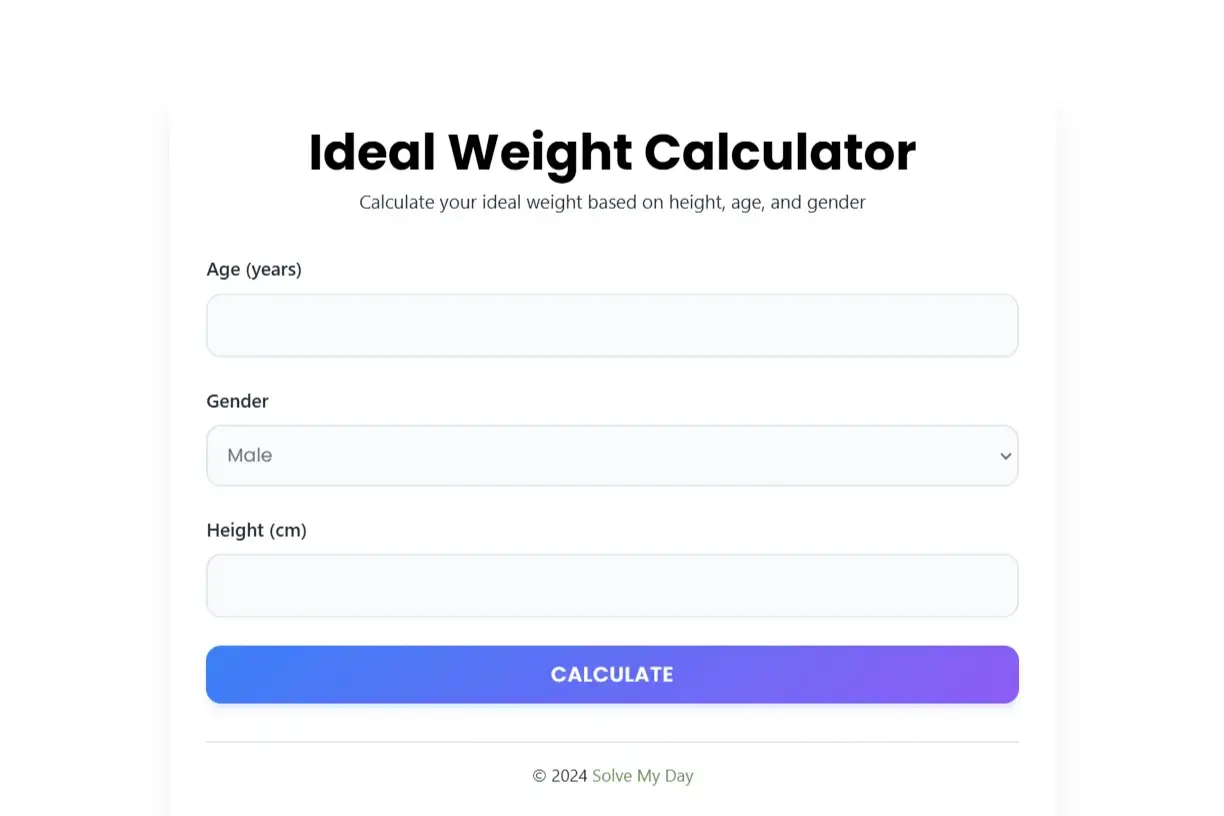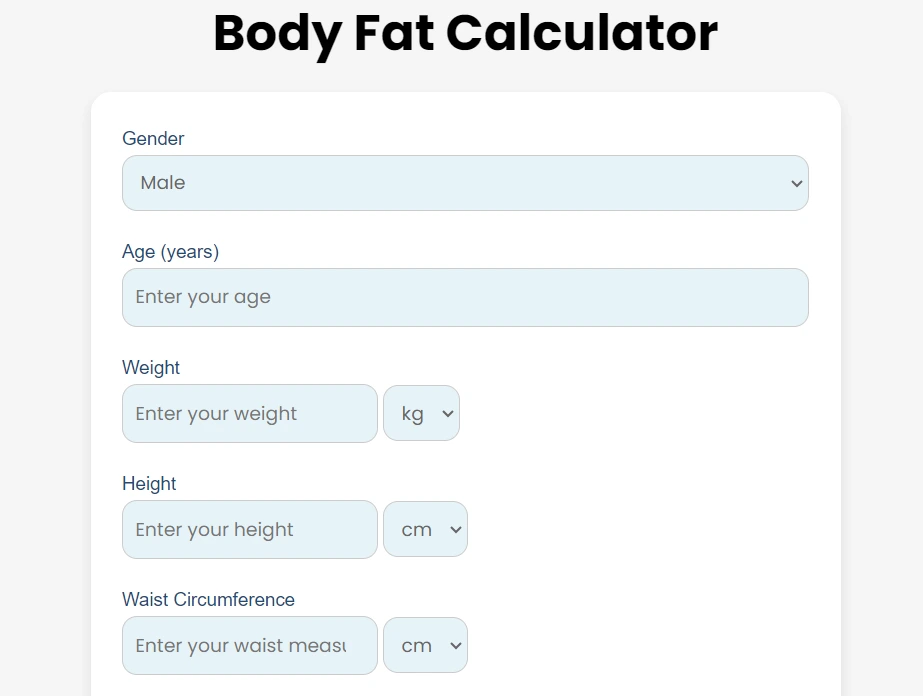Fat Free Mass Index Calculator
- Height: Stand straight against a wall without shoes and measure from floor to top of head in centimeters.
- Weight: Weigh yourself first thing in the morning after using the bathroom before eating for most accurate result.
- Body Fat: Use calipers, bioelectrical impedance scale, DEXA scan, or body fat calculator for best estimate.
- Enter your height in centimeters (cm)
- Enter your weight in kilograms (kg)
- Enter your body fat percentage (%)
- Select your gender
- Click “Calculate FFMI” to see your results
- The calculator will show your Fat Free Mass Index with interpretation
- Accuracy: Our calculator uses precise formulas with TensorFlow.js integration for enhanced calculations
- Gender-Specific: Different visualization and interpretation for males and females
- Visual Results: Beautiful charts and meters to understand your position
- Expert Insights: Get actionable recommendations based on your results
- Trustworthy: Used by fitness professionals worldwide
Your FFMI Results
Your Fat Free Mass Index (FFMI)
12
16
19
22
25
28+
Body Composition Analysis
FFMI Comparison
Interpretation
FFMI Calculator: The Ultimate Guide
You step on the scale. The number stares back at you. But does it tell the whole story?
Weight alone doesn’t define strength or fitness. Muscle does. That’s where FFMI (Fat-Free Mass Index) comes in. It strips away the noise and shows you what truly matters—how much lean mass your body carries.
Whether you’re an athlete, a fitness enthusiast, or just starting your journey, understanding your FFMI is a game-changer. This guide will walk you through what FFMI is, why it matters, how to calculate it, and how to improve it.
Let’s dive in.
What Is FFMI?
FFMI (Fat-Free Mass Index) measures the amount of lean muscle mass in your body relative to your height. Unlike BMI, which only considers weight, FFMI gives you a true picture of muscle vs. fat.
How is it different from BMI?
- BMI (Body Mass Index) lumps muscle and fat together, often misleading muscular people into thinking they are overweight.
- FFMI separates muscle from fat, giving a clear view of your lean body mass.
This makes FFMI a powerful tool for tracking fitness progress, setting realistic goals, and optimizing training.
Why FFMI Matters
Your FFMI tells you more than just a number. It tells a story.
🔹 Are you building muscle effectively?
🔹 Are you losing fat while preserving muscle?
🔹 Are you plateauing in your workouts?
FFMI helps you answer these questions. It’s the gold standard for measuring muscle development and is even used by sports scientists to assess athletic potential.
What’s a Good FFMI Score?
| FFMI Score | Category |
| <16 | Below Average |
| 16 – 19 | Average |
| 19 – 22 | Above Average |
| 22 – 25 | Excellent |
| 25+ | Exceptional (or possibly enhanced by steroids) |
An FFMI above 25 is rare in natural athletes. That’s why it’s often used to detect unnatural muscle growth.
How to Calculate Your FFMI
Enter Height (cm)
Enter Weight (kg)
Enter Body Fat Percentage (%)
Hit Calculate FFMI, and within seconds, you’ll know where you stand.
But what if you don’t know your body fat percentage?
You can estimate it using:
✅ Skinfold calipers (most accurate for home use)
✅ Bioelectrical impedance scales (available in many gyms)
✅ DEXA scans (gold standard, but expensive)
How to Improve Your FFMI
Want a higher FFMI? It’s not just about lifting heavy. You need strategy.
1. Prioritize Strength Training
FFMI rewards muscle mass, and nothing builds muscle like progressive overload.
✅ Focus on compound lifts (squats, deadlifts, bench press, pull-ups).
✅ Increase weights or reps consistently.
✅ Train each muscle group at least twice a week.
2. Optimize Your Nutrition
Your muscles grow in the kitchen.
✅ Eat enough protein (1.6 – 2.2g per kg of body weight).
✅ Fuel with whole foods (lean meats, fish, eggs, legumes).
✅ Stay hydrated (muscles are 76% water).
3. Keep Fat Levels in Check
More muscle and less fat = a higher FFMI.
✅ Aim for 10-20% body fat (men) or 18-28% (women) for optimal results.
✅ Cardio is great, but don’t overdo it—excessive cardio can burn muscle.
4. Prioritize Recovery
Muscle grows when you rest, not just when you lift.
✅ Get 7-9 hours of sleep per night.
✅ Take rest days seriously.
✅ Manage stress (high cortisol levels can eat away at muscle).
💡 Pro Tip: Track your FFMI every 4-6 weeks to monitor progress.
FFMI vs. Steroid Use: The 25+ Threshold
An FFMI over 25 is rare in natural lifters. Studies on elite bodybuilders show that almost all natural athletes stay below 25.
This is why some coaches and researchers use FFMI as a red flag for steroid use.
But if you’re close to 25 and natural, don’t panic. Genetics play a role, and some people naturally have a higher FFMI.
FAQs About FFMI Calculator
1. What is a healthy FFMI?
2. How do I increase my FFMI fast?
3. Can FFMI predict my physique?
4. Is FFMI the same for men and women?
5. What if my FFMI is low?
6. Does FFMI account for bone density?
7. Should I worry about FFMI if I just want to lose weight?
The Final Word: Take Control of Your Fitness with FFMI
Numbers don’t lie. FFMI gives you the truth about your lean muscle mass.
It’s not just about how much you weigh. It’s about how much of that weight is muscle.
🏋️♂️ Want to track your muscle growth?
💪 Want to ensure you’re losing fat, not muscle?
🔍 Want a fitness metric more accurate than BMI?
Then use the FFMI calculator below.
Know your number. Track your progress. Build your best body.
👉 Enter your details now and unlock your true potential.




